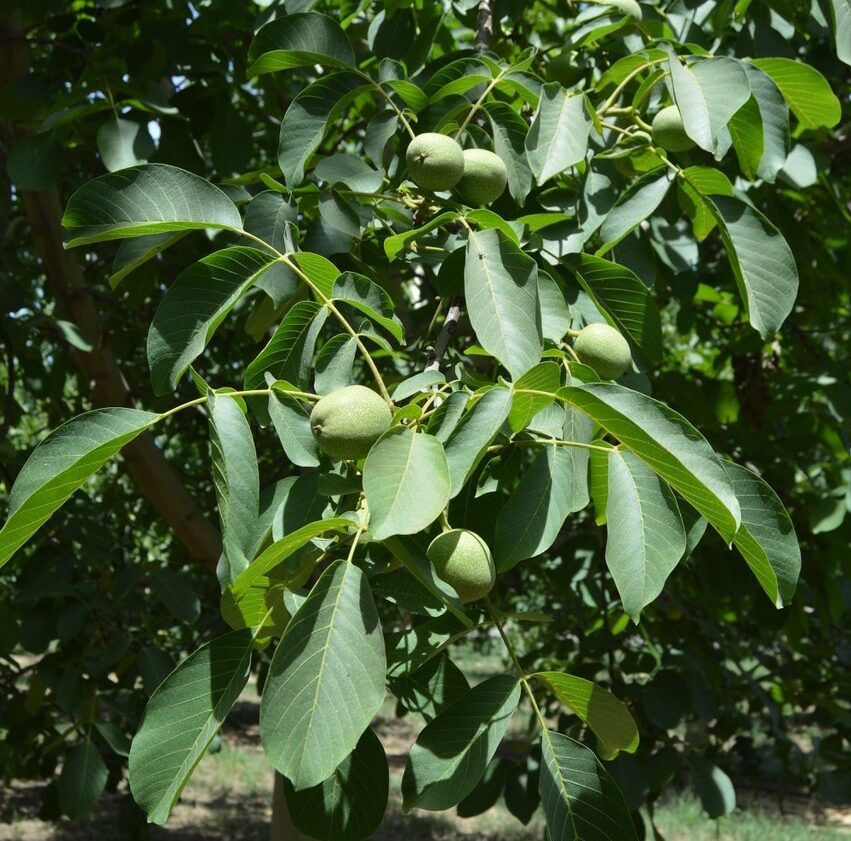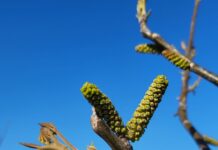Before the UC Davis Walnut Improvement Program was founded in 1948 by Gene Serr and Harold Forde, there was no Chandler, Howard or Tulare. Popular cultivars at that time were terminal bearing, including Franquette, which was introduced from France in the 1870s, and Hartley, which won a blue ribbon at the 1915 World Fair. Serr and Forde worked together to combine the late leafing and blight avoidance found in Franquette with the lateral bearing and precocity from Payne, a fence-row seedling from California, and 23 cultivars later, the rest is history.
Combining Genetics
Today, we can use DNA technology to understand Serr and Forde’s accomplishments. We found an allele, a segment of DNA, from Franquette on one of its 16 chromosomes that confers late leafing, and an allele from Payne that confers lateral bearing. Chandler and Howard are both heterozygous (containing one copy) for both of these alleles. Tulare is heterozygous for the late leafing allele and homozygous (containing two copies) for the lateral bearing allele.
In spring 2021, we released UC Wolfskill, the Walnut Improvement Program’s twenty-third cultivar. Like other recent releases, including Ivanhoe and Solano, Wolfskill is heterozygous for the lateral bearing allele but does not contain the late-leafing allele from Franquette. For this reason, Wolfskill leafs out in mid-March, sometimes during spring rains (remember those?), and does not follow the “blight avoidance” strategy of late-leafing Chandler, Howard and Tulare. What is going on? Why is the Walnut Improvement Program changing direction?
The Catch-22 for blight avoidance through late leafing is that in walnut, as in most other deciduous tree crops, late leafing is correlated with higher chill requirement. Our data show that Chandler, Howard and Tulare all have higher chill requirements than Wolfskill, Solano and Ivanhoe, and we all know that chill hours (or units or portions, if you prefer) are declining in California. There may be some healthy disagreement over exactly how quickly this is going to happen, but it’s a fair bet that, as we are already seeing in some years, late leafing cultivars will have more staggered bloom and other problems related to inadequate chill in the decades to come.
Early-leafing walnut varieties may come with another hidden benefit: increased precocity and yield. Our recent analysis of the early leafing allele in the breeding program shows that homozygotes for this allele (like Wolfskill, Solano and Ivanhoe) are on average more precocious and more lateral bearing (producing more flowers and nuts from the previous winter’s lateral buds) than heterozygotes (like Chandler, Howard and Tulare.) Of course, there are other factors affecting precocity and lateral bearing. Tulare is the only cultivar of these six that is homozygous for the lateral bearing allele from Payne. Homozygotes for both early leafing and lateral bearing are expected to be the best, but there are no released cultivars like this yet.
Genetic diversity in plant breeding cuts both ways. There are two lateral bearing alleles that we know of: one from Payne, which predominates in the breeding program, and another from Xinjiang Province in Western China, which seems to be associated with higher precocity. Actually, heterozygous individuals carrying one Payne allele and one Xinjiang allele (but homozygous lateral bearing) are most precocious of all; most of these trees produce nuts in their second year as seedlings, indicating that they begin producing female flower buds within six months after germination. However, you can’t take precocity to the bank, and higher yields may not be worth it if they come with greater variation in nut quality. Genetic changes that enable higher yields could require adjustments to tree spacing and pruning before becoming profitable. Ultimately, we rely on data from regional trials of advanced selections hosted by growers to determine which selections to advance for additional testing and, eventually, cultivar release.
Crafting Future Cultivars
As we have moved over the last 70 years to varieties earlier then Franquette, we have sacrificed blight avoidance, and management options for control have predominated. But incorporation of genetic resistance into new varieties is an important goal. Genetic improvement is slower but, when it arrives, can be adopted into new plantings at no extra cost to the grower. Here in the Walnut Improvement Program, we were probably the only walnut growers in the state to be disappointed by the lack of blight development this spring. But the fact is, if we don’t see blight, we can’t select for blight resistance. We are examining methods to impose blight pressure more uniformly from year to year on material of interest.
Perhaps the most difficult puzzle in walnut breeding is how to craft a cultivar that is not only more profitable for growers, but also produces a product with superior nutrition, appearance and taste. It is no secret that walnuts are healthy; the kernels contain high levels of polyunsaturated fatty acids, a kind of healthy fat also found in seafood and flaxseed. And the walnut “skin”, or pellicle, contains high levels of tannins, which have been associated with a variety of health benefits. But polyunsaturated fats have a shorter shelf-life at room temperature than other fats, and some consumers find the astringency of tannins unappealing.
To begin solving this problem, we’re working with food chemist Selina Wang to find walnut varieties in our collection with increased shelf life. So far, we’ve found one promising variety with increased shelf life that is already in widespread use in the breeding program. Called PI159568, it comes from a tree in Paghman, Afghanistan from which nuts were collected by the USDA in 1937 and planted at Chico. Years later, one of those seedling trees caught the eye of Serr and Forde. 70 years later, it is catching our eye once again.











